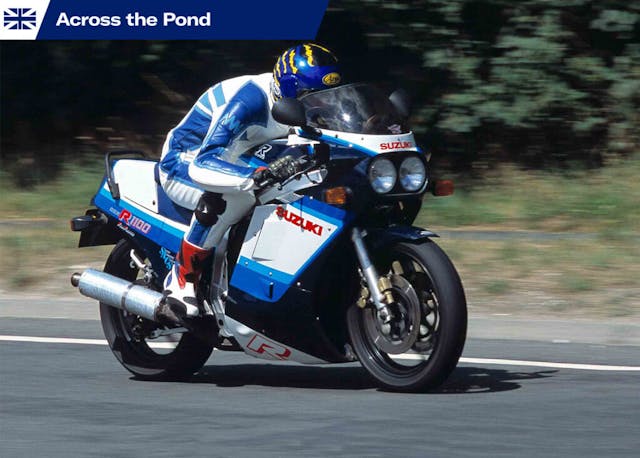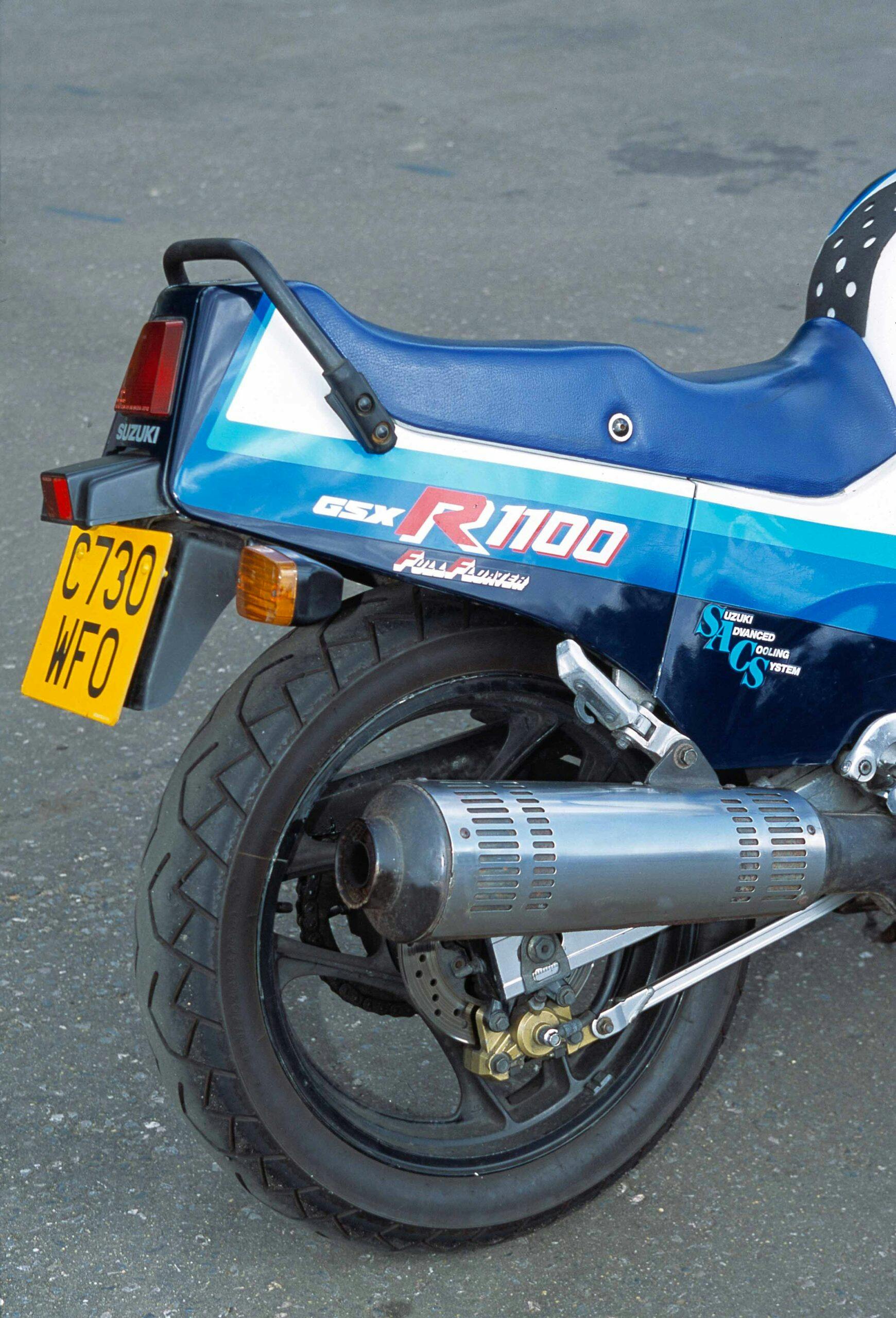This 1986 Suzuki was so fast, I had to rewire my brain

In 2022, Suzuki had to drop the GSX-R1000R from its Japan and European catalogs because the model couldn’t meet emissions regulations under Euro-5. The decision ended an open-class line that stretches all the way back to the original GSX-R1100 of 1986.
37 years later, one incident from my first ride on that motorcycle remains as vivid as if it happened yesterday.
On a Surrey A-road on what felt like the year’s first real day of spring, early morning mist had burned off to reveal bright sunshine. As a tester for Bike magazine, I had just been let loose on a freshly uncrated example of Suzuki’s 1052cc follow-up to the GSX-R750, which in 1985 had redefined high-performance motorcycling.
Ahead was a long, slightly uphill straight. I opened up the Suzuki properly for the first time. With my head behind the screen, the GSX-R ripped forward so hard that it almost left my stomach at the bottom of the hill. When I tipped the bike into the curve at the top, at a speed no longer politically correct to mention in print, the GSX remained rock-steady: It could clearly have gone faster still with no problem.
I instantly realized that the GSX-R1100 was in a different league than anything I’d ridden in several years as a road-tester. A further two weeks with the bike did nothing to alter that view.

The big GSX-R’s all-conquering performance was not unexpected. A year earlier the original GSX-R750 had been a shock: Its full fairing, racy riding position, rev-happy oil-cooled engine, and ultra-light aluminum-framed chassis put an unprecedented focus on speed and aggression.
The 1986 GSX-R1100 was more of the same: A bigger, stronger 16-valve powerplant in an uprated and still remarkably light chassis. At a glance, it was almost indistinguishable from its smaller sibling, apart from the stickers on its tailpiece. The two models shared Suzuki’s endurance racer styling, with round twin headlamps in a fairing that would later earn them the nickname “Slabside.”
The frame design was very similar, too: a collection of rectangular-section extrusions in a twin-downtube arrangement, with cast sections at the steering head and around the pivot of a box-section swing-arm, which was also made of aluminum.

The engine layout followed that of the smaller GSX-R, which meant oil cooling, and 16 valves in Suzuki’s familiar Twin Swirl Combustion Chamber design. It too was designed to prioritize weight-saving, but some parts, notably the five-speed (instead of six-speed) gearbox, were strengthened.
The engine’s larger capacity gave the bike very different power characteristics. Where the 750cc bike demanded high revs, the GSX-R1100 was much more flexible. Its power curve impressed not just with its peak of 128 hp at 8500 rpm but also with its broad spread of torque.
That power output is modest for a big bike today, of course. When I found myself back behind the tall twin-headlamp fairing, there was inevitably not the same sense of all-conquering performance. But the big Suzuki still took very little time to make its presence felt.

The view from the rider’s seat was instantly familiar: usefully protective screen, foam-mounted instruments, low, clip-on handlebars. And the GSX-R still ripped forward like crazy when I tweaked its throttle, even when the tacho needle was barely off its 3000 rpm stop.
By the time I was into top gear on this well-preserved GSX-R, it was clear that the old warrior still had the performance to feel seriously quick on the road. By 5000 rpm it was ripping forward violently enough to lift its front wheel in first gear. Even in top, it could surge past a line of traffic.
At 7000 rpm, where the smaller GSX-R engine came alive, the 1100 was breathing even deeper as it headed for the 10,500 rpm redline and ever-greater speeds. In typical GSX-R fashion, there was a slight buzziness to the engine. But vibration never really became annoying, unlike the footrests—I hadn’t recalled them being quite so knee-crampingly high.

Acceleration was also aided by the GSX-R1100’s weight or, rather, its lack of weight. At 434 pounds dry it was 44 pounds heavier than the 750, due to many of its apparently identical parts being slightly larger and stronger. But that figure still made the Suzuki by far the lightest open-class machine in its day; with a standing quarter-mile time of less than 11 seconds, it made rivals like Honda’s VF1000R and Kawasaki’s GPZ900R seem sluggish.
Equally importantly, it was just as impressive in the twisties. That beefed-up frame held front forks developed from the 750’s, and a new rear shock. It had wider 18-inch wheels and tires, and larger 310mm front brake discs gripped by identical four-piston calipers. Stability was aided by a steering damper tucked inside the fairing nose.
On that first ride in the ’80s, my main impression had been of how light, taut, and racer-like the Suzuki had felt in comparison with existing superbikes. My thoughts were very different years later, when its 18-inch wheels and old-fashioned geometry made the GSX feel more broadsword than rapier.
It still responded well to spirited riding, feeling sufficiently light and flickable to encourage some aggression in the bends. Its Bridgestone tires were narrow by modern standards but not short of grip. The front brake was reasonably powerful, too, though of course lacking in ABS.
Unlike many of its contemporaries, the GSX-R also had enough ground clearance, even for the racetrack. It had proven so in 1986 by utterly dominating production racing with no more extra kit than a lock-wire on its annoying, spring-loaded sidestand. It took the top eight places both in the national championship and at the Isle of Man TT, where winner Trevor Nation lapped the 37-mile course at over 113 mph.
My first impression on that sunny spring morning in the ’80s had not been misleading. All these years later, it’s debatable whether any new superbike since has been so far ahead of all opposition as that first GSX-R1100. Its family line might have ended in most of the world, but Suzuki’s slab-sided star won’t be forgotten.

1986 Suzuki GSX-R1100
Highs: Riding it hard on a twisty road
Lows: The low bars and high footrests in town
Summary: It still feels improbably fast and light
—
Price: Project, $4800; nice ride, $11,000; showing off, $16,400
Engine: Oil-cooled DOHC four
Capacity: 1052 cc
Maximum power: 125 hp @ 8500 rpm
Weight: 434 pounds without fluids
Top speed: 150 mph
***
Check out the Hagerty Media homepage so you don’t miss a single story, or better yet, bookmark it. To get our best stories delivered right to your inbox, subscribe to our newsletters.





Great article! Love the vivid description of the riding experience. I’m glad that meeting an old hero didn’t disappoint.